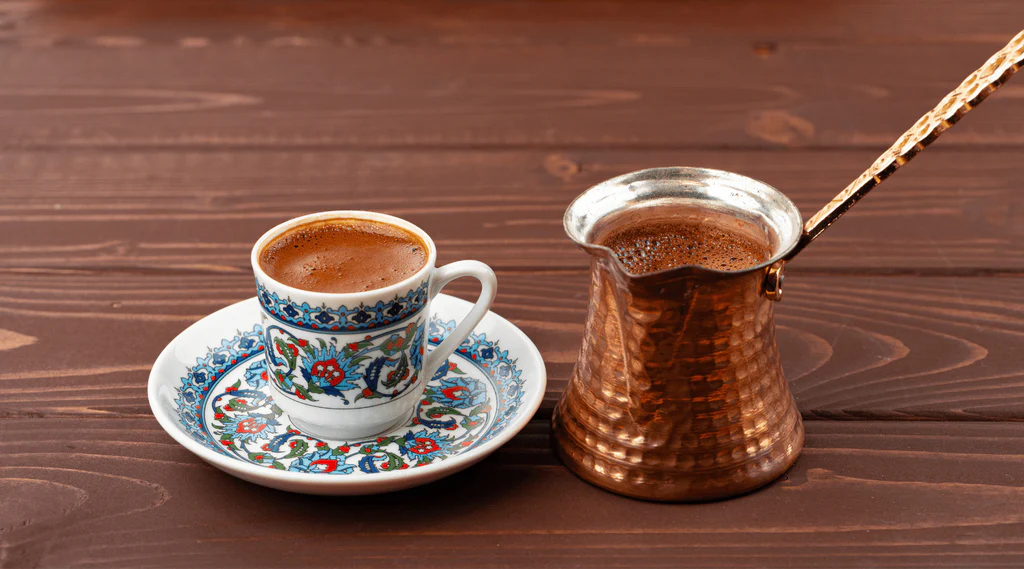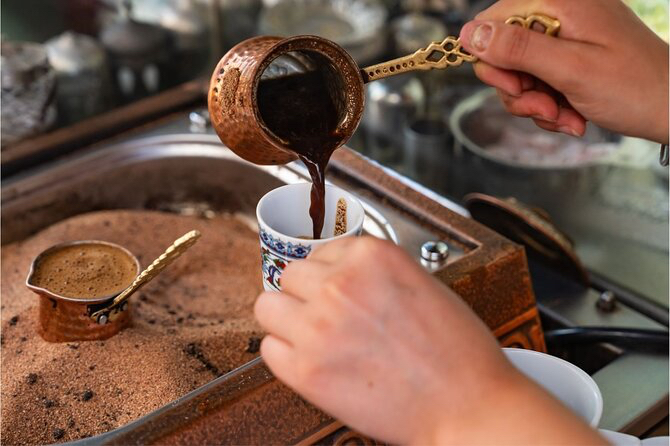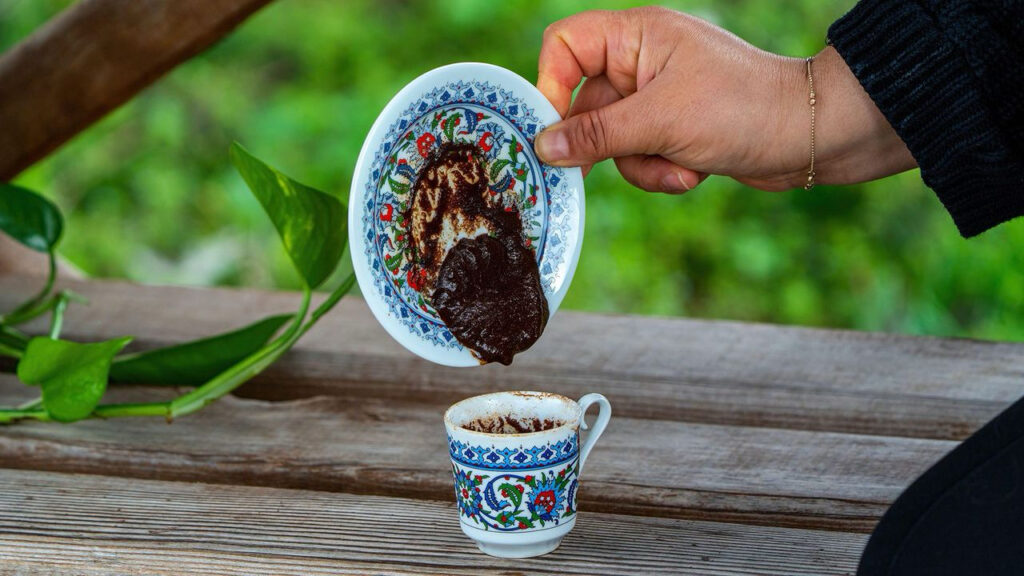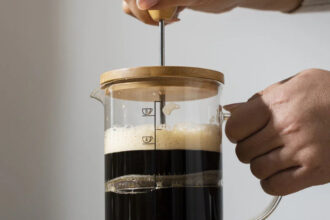If espresso is precision and pour-over is patience, then Turkish coffee is pure ritual. It’s one of the oldest brewing methods in the world — thick, strong, and unfiltered — yet surprisingly easy to make at home once you know the technique.
Steeped in history and served with ceremony, Turkish coffee isn’t just a beverage; it’s a cultural experience. Each tiny cup tells a story — of hospitality, conversation, and centuries-old traditions that have stood the test of time.
Here’s a complete, barista-approved guide to brewing authentic Turkish coffee right in your kitchen.
What Makes Turkish Coffee Unique

Turkish coffee is unlike any other brew. It’s made from ultra-fine coffee grounds, simmered (not boiled) in water and sugar, traditionally in a small copper pot called a cezve (or ibrik). The result is a thick, aromatic coffee with a layer of foam on top and fine grounds settling at the bottom.
There are a few key traits that define Turkish coffee:
- No filter: Grounds stay in the cup — they’re part of the texture and flavour.
- No milk or cream: Just coffee, water, and optional sugar.
- No rushing: It’s brewed slowly, over low heat, for a creamy, foamy finish.
A Little History
Turkish coffee dates back to the 16th century Ottoman Empire, where it was first introduced to Istanbul. Coffeehouses soon became intellectual hubs where poets, philosophers, and merchants gathered — the forerunners of today’s cafés.
In 2013, UNESCO even added Turkish coffee to its Intangible Cultural Heritage list, recognising it as a symbol of hospitality and community across the Middle East and the Mediterranean.
What You’ll Need

Making Turkish coffee doesn’t require fancy equipment — just a few simple tools:
- Cezve (Ibrik): A small, long-handled pot (traditionally copper or brass)
- Finely ground coffee: Extra-fine, almost powdery (finer than espresso)
- Filtered water
- Sugar (optional)
- Small demitasse cups
If you don’t have a cezve, a small saucepan will work in a pinch, though you’ll miss some of the signature foam.
Choosing the Right Coffee
For an authentic experience, use Arabica beans roasted medium to dark, ground to a flour-like consistency.
You can find pre-ground Turkish coffee from brands like Kurukahveci Mehmet Efendi, or grind your own using a burr grinder set to its finest setting. The grind is crucial — it’s what gives Turkish coffee its velvety mouthfeel and layered flavour.
Step-by-Step: How to Brew Turkish Coffee

Here’s how to make perfect Turkish coffee at home — slow, rich, and aromatic.
1. Measure Your Ingredients
For one serving:
- 1 heaping teaspoon (6–7g) of finely ground Turkish coffee
- 1 demitasse cup (about 90ml) of cold water
- Sugar to taste:
- Sade (no sugar)
- Az şekerli (half teaspoon sugar)
- Orta (one teaspoon)
- Şekerli (two teaspoons, sweet)
Add sugar before brewing — never after. This helps it dissolve evenly into the coffee.
2. Combine and Stir
Add coffee, sugar, and cold water to the cezve. Stir gently until everything is mixed and the coffee dissolves into the water.
Do not stir again once it’s on the heat.
3. Heat Slowly
Place your cezve over low heat. Turkish coffee should never boil violently — it’s gently heated to extract maximum flavour without burning the grounds.
As it warms up, a thick foam (called köpük) will form on top. When the foam rises close to the rim (just before boiling), remove the cezve from the heat.
4. Serve with Foam
Spoon a little of the foam into each cup, then pour the remaining coffee slowly to distribute it evenly. The grounds will naturally settle to the bottom.
Pro tip: Don’t drink the last sip — it’s mostly sediment!
How to Serve It
Turkish coffee is traditionally served with a glass of water (to cleanse the palate) and a small sweet treat like Turkish delight or baklava.
The presentation is just as important as the flavour — it’s part of the ritual. The cups are small, the portions strong, and the moment unhurried.
In Turkish culture, coffee is often served to guests as a gesture of warmth and friendship — and sometimes even plays a role in wedding traditions, where brides-to-be brew coffee for their future in-laws as a symbol of skill and respect.
The Art of Coffee Fortune-Telling

One of the most charming customs tied to Turkish coffee is tasseography — fortune-telling from coffee grounds.
After finishing your cup, the drinker flips it upside down onto the saucer and lets it cool. The patterns left by the grounds are then interpreted for clues about love, success, and the future.
Whether you believe it or not, it’s a fun (and distinctly Turkish) way to end your coffee session.
Tips for a Perfect Brew
- Use cold water: It helps the foam develop slowly and evenly.
- Low heat is key: Patience pays off — rushing the process burns the grounds.
- Never reheat Turkish coffee: It ruins the texture and flavour.
- Serve immediately: Foam dissipates quickly once poured.
- Experiment with spices: Add a pinch of cardamom, cinnamon, or clove for a Middle Eastern twist.
Variations Across Regions
Turkish coffee inspired similar brewing traditions across the Middle East and Balkans — each with its own local touch:
- Greek Coffee (Ellinikos): Nearly identical, but often slightly lighter in roast.
- Bosnian Coffee: Brewed with more water and served with sugar cubes on the side.
- Arab Coffee (Qahwa): Infused with cardamom, often served in larger gatherings.
Though the methods differ, the spirit is the same — slow coffee meant to be shared, not rushed.
Why Turkish Coffee Still Matters
In an era of fast espresso shots and instant pods, Turkish coffee remains a reminder of what coffee once was: a ritual, not a routine.
It teaches patience — from the gentle simmering to the mindful sipping. It connects people — through shared moments, conversation, and culture. And most of all, it proves that great coffee doesn’t need machines or modern gadgets — just good beans, slow heat, and a little love.
Final Thoughts
Brewing Turkish coffee at home is an experience that bridges past and present — equal parts history, craft, and comfort.
It’s not just about caffeine; it’s about connection. Whether you’re sitting on your balcony in Singapore or in a cozy kitchen halfway across the world, a cezve on the stove brings a piece of Turkish tradition right to your cup.
So next time you crave something different, skip the espresso machine and reach for a cezve instead. Let the aroma fill your kitchen, pour yourself a small cup, and savour coffee the way it’s been enjoyed for centuries — slowly, richly, and with meaning.



